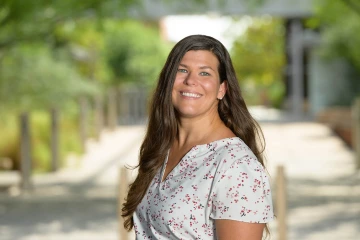On a personal journey to solve the migraine puzzle
Tally Largent-Milnes, PhD, who once aspired to be a physician, has carved out an impactful space in the field of migraine research.

Competitive and curious from a young age, Tally Largent-Milnes, PhD, is driven to understand what triggers migraine headaches and how researchers can develop more effective therapies for people, including herself, who live with the neurological disease.
In sixth grade, Tally Largent-Milnes, PhD, woke up one morning with a headache – a really bad one. Yet more powerful than the headache was Largent-Milnes’ competitive drive; she had a perfect attendance record to keep intact. So, Largent-Milnes got out of bed and went to the kitchen, where her mother and siblings were gathered for breakfast. But something wasn’t right. The lower half of her vision was gone, and her family members appeared as if they were floating torsos. Largent-Milnes’ mother suggested that she stay home from school.

As a member of the Comprehensive Center for Pain and Addiction, Tally Largent-Milnes, PhD, studies chronic pain and migraine, a condition she shares with her mother and brother.
“I’m not staying home,” Largent-Milnes replied emphatically.
While her vision slowly returned that morning, Largent-Milnes’ headache persisted. Then, in between classes, she vomited. Teachers directed her to the school nurse, who sent Largent-Milnes home. Though she was not formally diagnosed for couple of years, Largent-Milnes had experienced her first migraine headache.
“I was scared because I had never not been able to see before,” Largent-Milnes said. “I was asking myself, ‘Is my vision going to come back?’ I probably should have made a bigger deal out of it than I did at the time, but I didn’t think as much about that until later in life. At the time, I was focused on the fact I was able to keep my perfect attendance record.”
Though she didn’t know it, migraine headaches were more than just a condition she, her mother and brother shared; migraine would become a critical focus of her career’s work as a chronic pain researcher.
Now a member of the University of Arizona Health Sciences Comprehensive Center for Pain and Addiction, Largent-Milnes is studying how to target the endogenous cannabinoid system to develop new and potentially sex-selective preventative and therapeutic drugs for migraine.
Burning questions
Largent-Milnes grew up in Glendale, Arizona, in a blended family. Her brothers aspired to work in the fire service or the military, while her older sister went on to own her own businesses. Largent-Milnes, though, always wanted to be a doctor. Specifically, she wanted to practice geriatric emergency medicine.

As a child, migraine headaches were a challenging reality for Largent-Milnes, though she never let them keep her from attending school or competing in sports.
That was her plan when she enrolled at the University of Arizona in the early 2000s. She studied biochemistry and molecular and cellular biology with the intention of applying for medical school upon graduation. As part of her biochemistry major, she needed to complete two semesters in a research lab. That was when she met Todd Vanderah, PhD, Regents Professor and head of the UArizona College of Medicine – Tucson’s Department of Pharmacology.
“We got to talking about his research and the opportunities in his lab, and it just clicked,” Largent-Milnes said. “I basically started working with him that same day.”
Over the next two years, Largent-Milnes found her calling as a researcher. Among her contributions to the Vanderah Lab, her biochemistry studies were useful in helping understand the mechanisms that made a low-dose opioid drug a promising candidate for a phase 3 clinical trial.
“I quickly realized she was all about learning research and was excited about making progress on opioid receptor coupling and how kappa opioid agonists may be used for some types of pain,” Vanderah recalled. “Tally’s willingness to learn and her insightful ways of testing opioid receptor activity was exactly what my lab needed at the time.”
Largent-Milnes still planned to pursue medical school, but that was easier said than done. She was already paying her way through undergraduate courses, and paying for medical school would be an obstacle.
And there was one other thing: “I don’t like sick people,” Largent-Milnes said. “I have compassion for sick people, but it frustrates me when people don’t take the advice of their doctors.”
Largent-Milnes’ career goals began to shift when Vanderah asked her: “Why go to medical school when you can do research?”
It was a simple question that resonated deeply with Largent-Milnes. Not only was it more feasible financially, it also opened the door for her to answer another question she carried with her from a young age.

Largent-Milnes met her husband, Philippe Coursodon, while completing her doctorate in pharmacology at the University of Arizona College of Medicine – Tucson. Their daughter, Colette, was born in 2016 after Largent-Milnes returned to the UArizona Department of Pharmacology as a faculty member.
“Basically, I had this pressing question: why can I walk outside in the middle of the summer barefoot? It would be 100 degrees and I could walk outside to get the mail, but my sister, who is seven years older than me, would refuse to do that,” Largent-Milnes said. “I decided I would go to graduate school and try to understand spinal circuits so I could answer my silly childhood question.”
If Largent-Milnes had any lingering reservations about her decision to forego medical school, they were soon put rest. The courses she took as part of the Medical Pharmacology Graduate Program always led her to ask more questions.
“After every class, I was like, ‘But what about this mechanism, or what about this small thing? And that really solidified for me that maybe medicine is not for me right now. Research is really what I wanted to do, and if I wanted to, later on, I could still do medicine.”
Carving out her own space
After Largent-Milnes received her doctorate in pharmacology in 2010, she started postdoctoral work at Oregon Health and Science University to become a better neuroscientist.
“I knew I wanted to have my horizons broadened from a scientific standpoint,” Largent-Milnes, who took a keen interest in learning about electrophysiology, the branch of physiology that studies the electrical properties of biological cells and tissues. “I got my own National Institutes of Health funding, and I was able to learn a lot of new things that built off what I already knew from my pharmacology background.”
Largent-Milnes completed her postdoctoral work in 2014 and accepted an offer from Vanderah to return to the University of Arizona. It was a move that would bring her life and career full circle. Today, she is a tenured associate professor of pharmacology at the College of Medicine – Tucson.
Along with Vanderah, pharmacology professors Frank Porreca, PhD, and Thomas Davis, PhD, became key mentors for Largent-Milnes. They were instrumental in helping her receive her first R01 grant in 2018 and encouraged her to pursue migraine research.
At least 39 million Americans live with migraine, but because many people do not get a diagnosis, the actual number is probably higher, according to the American Migraine Foundation.
“I’ll be totally honest, I did not want to be in the migraine space,” Largent-Milnes said. “Frank was so well-established in the field, and I didn’t want to be competing against someone so well-respected in my own department.”
Largent-Milnes discussed the idea further with her colleagues, who pointed out that the migraine field was 20-30 years behind the research in related areas of chronic pain and addiction, so there was potential for Largent-Milnes to carve out her own space. Even understanding what triggers a migraine at the mechanistic levels is a question that puzzles scientists to this day.
“If I ask someone what diabetes is, they could say that your pancreas isn’t working, and you have bad blood sugar,” Largent-Milnes explained. “You go straight to pathology, and there is a mechanistic answer. Well, with migraine there is no answer. Is it vascular? Is it neural? Is it neurovascular? We are looking at migraines from all these different perspectives.”
Vanderah praises Largent-Milnes’ research discoveries, including how a migraine headache may result in the activation of neuronal networks in the brainstem. Her work also focuses on the role of endogenous cannabinoids in migraine, which may lead to new ways to help those people with migraine.

Genetics can play a significant role in migraine. Like her mother, Terri Largent (left), Largent-Milnes (right), began experiencing migraine headaches as a child. Terri says she often found relief from migraine symptoms by spending time around her father’s horses.
“Tally has had an incredible impact on the field of chronic pain,” Vanderah said. “Our early work together resulted in the first studies that determined how the brainstem may promote pain in certain conditions, resulting in chronic pain. We also showed that sustained opioid administration resulted in the increase in certain peptides to promote pain in the brainstem, which helped explain opioid analgesic tolerance. These types of studies, along with our interest in the endogenous cannabinoid system, has led to Tally’s success in studying migraine. Her hard work and dedication to research is what helped make my career successful as a scientist and professor.”
Pursuing answers to the challenging questions continues to drive Largent-Milnes. She remains fueled by the curiosity she had as a child, wondering why her sister couldn’t walk outside barefoot.
“We have different personal lived experiences, in addition to the biological, molecular and cellular factors that make us all unique,” Largent-Milnes said. “We all experience pain differently, and measuring pain is very subjective.
“We don’t all go from point A to point B the same way, but I like to think of the body as one big giant Lego box with a fixed number of pieces. Sometimes our bodies are put together exactly how the instructions intend, but sometimes pieces are not in the right places,” she added. “Through science, we are learning ways in which we can change how the pieces are used. And hopefully through our work we are getting closer to understanding the pieces of the migraine puzzle.”
Our Experts
Tally Largent-Milnes, PhD
Associate Professor, Department of Pharmacology, College of Medicine – Tucson
Member, Comprehensive Center for Pain and Addiction, UArizona Health Sciences
Member, BIO5 Institute
Todd Vanderah, PhD
Regents Professor and Head, Department of Pharmacology, College of Medicine – Tucson
Director, Comprehensive Center for Pain and Addiction, UArizona Health Sciences
Co-Director, MD/PhD Dual Degree Program
Professor, Anesthesiology
Professor, Neurology
Member, BIO5 Institute
Member, Cancer Biology Program, UArizona Cancer Center
Contact
Blair Willis
UArizona Health Sciences
520-419-2979
bmw23@arizona.edu

